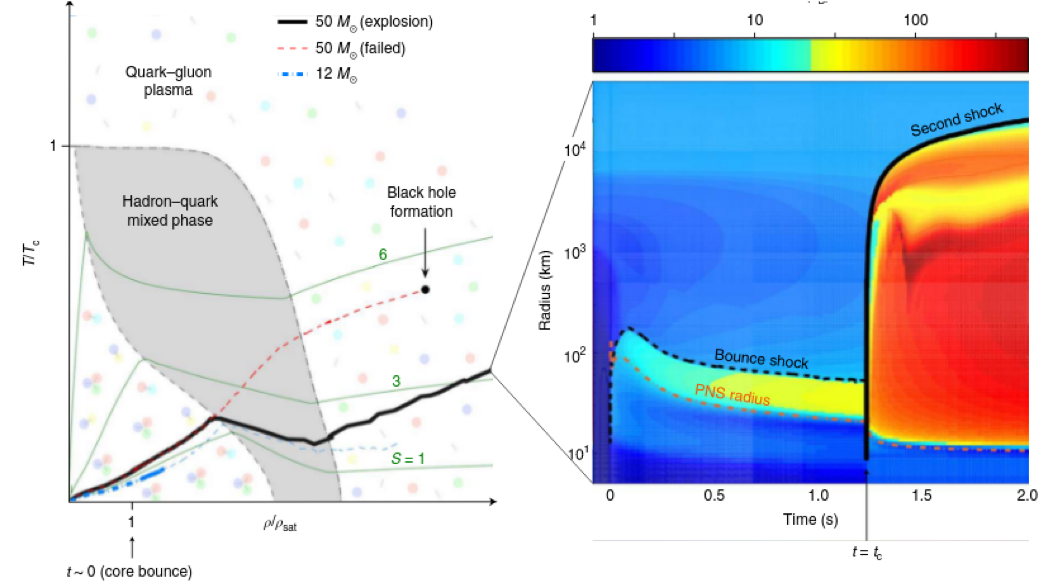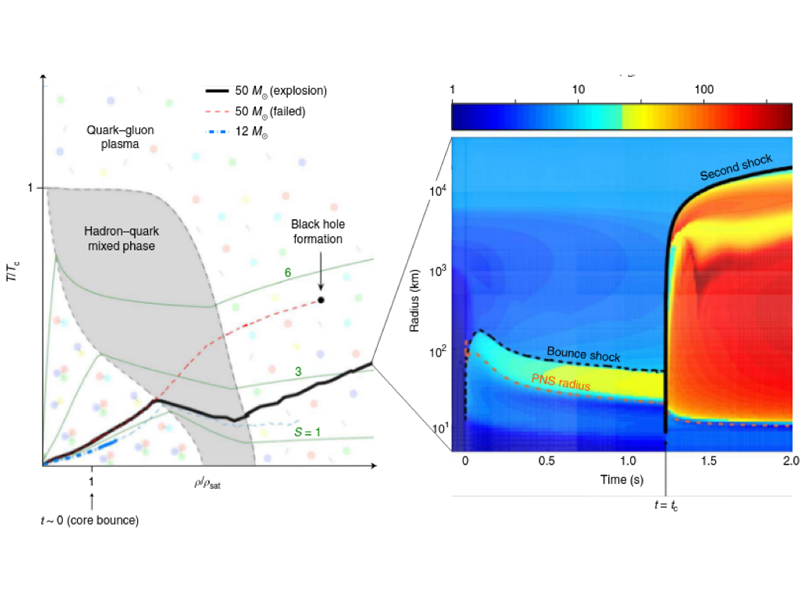【Supernova explosion triggered by quark-hadron phase transition】How does physics that governs the sub-atomic scale be related to the astronomical observation of supernova explosions and neutron stars?

© FISCHER, T. ET AL.: QUARK DECONFINEMENT AS A SUPERNOVA EXPLOSION ENGINE FOR MASSIVE BLUE SUPERGIANT STARS. IN: NATURE ASTRONOMY, 10.1038/S41550-018-0583-0, 2018, FIG. 1.
A team consists of several physicists and astrophysicists from Germany, Poland, Russia, Taiwan, including our assistant research fellow Dr. Meng-Ru Wu, has shown that a possible first-order transition from the hadronic state to the quark state at super-nuclear saturation density can help explain two astronomical puzzles:(1) How do very massive stars die as supernovae? (2) How were heavy neutron stars born in nature?
In the typical theory of core-collapse supernova, the explosion is triggered by the so-called “neutrino-driven” mechanism, within which the neutrinos are responsible for transferring the energy from the central remnant to the stalled shock in order to explode the entire star. However, over the past decades, researchers found that for very massive stars that weight about 50 solar mass, such an energy transfer mechanism is not powerful enough to deliver a successful explosion. Nevertheless, supernova explosions associated with these massive stars were in fact seen by telescope observations, which still puzzles astrophysicists. In this novel work, it was found that, deeply inside the proto-neutron star formed during the gravitational core-collapse, if a first-order phase transition from the hadronic phase to the quark phase occurs at a density that is about 2 times larger than the nuclear saturation density, a second collapse can happen within the proto-neutron star and generates a powerful shock that is strong enough to explode the whole star as heavy as 50 solar mass initially. Moreover, the remnant left behind from such an explosion will be a “neutron star” with a quark core that weights about 2 times of the solar mass. This naturally provides a formation mechanism for the observed heaviest neutron star in the Universe.
Such strong explosions can also yield very bright transients on the sky, with the brightness ranging between the normal supernovae and the super-luminous supernovae, thereby offering a potential connection between massive stars and super-luminous supernovae. In addition, this work predicts that if such an explosion happens in our Milky Way galaxy, the existing and future multi-kiloton neutrino detectors will be able to record a unique “milli-second” neutrino burst to confirm this scenario.
This work “quark deconfinement as a supernova explosion engine for massive blue supergiant stars” was lead by Dr. Tobias Fischer in the University of Wroclaw and has been published in the journal Nature Astronomy
Full read-only text can be found here:
https://rdcu.be/9PiS
Related scientific news:
https://physicsworld.com/a/quark-deconfinement-drives-supernovae-in-blue-supergiant-stars-say-astrophysicists/ (English)
https://www.space.com/42295-blue-supergiant-stars-supernova-quarks.html (English)
https://www.spektrum.de/news/quarkmaterie-laesst-supernova-explodieren/1604020 (German)
https://ria.ru/science/20181022/1531215771.html (Russian)
